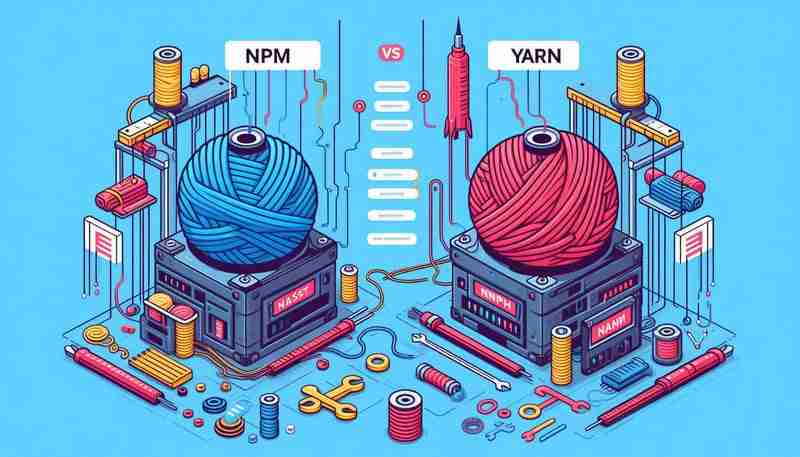npm 与yarn:主要区别和深入比较
在 JavaScript 生态系统中,选择 npm 与 YARN 作为包管理器可以显着影响您的开发工作流程。 npm 和yarn 都是广泛使用的工具,可帮助开发人员管理项目中的依赖项,但每种工具都提供独特的功能来满足不同的项目需求。 npm 与yarn 的深入比较涵盖了它们的主要差异、优势和用例,可帮助您为项目做出明智的决策。

1. 安装及依赖解析
新项目管理
npm 按顺序安装依赖项并在 node_modules 文件夹中创建嵌套结构,这可能会导致安装时间更长并可能导致依赖项重复。看起来像这样:
project/ ├── node_modules/ │ ├── package-a/ │ │ └── node_modules/ │ │ └── package-b/ │ └── package-c/
优点:
- 熟悉程度: npm 预装了 Node.js,使其成为许多开发人员的默认包管理器。
- 广泛的兼容性: 借助 npm 庞大的生态系统,大多数 JavaScript 项目无需额外设置即可无缝运行。
缺点:
- 性能:顺序安装可能会导致安装速度变慢,尤其是对于大型项目。
- 嵌套依赖项:依赖项的深度嵌套可能会导致 node_modules 文件夹臃肿,有时会导致限制目录深度的文件系统问题。
纱
Yarn 通过使用并行安装改进了 npm 的安装过程,从而创建了扁平结构:
project/ ├── node_modules/ │ ├── package-a/ │ ├── package-b/ │ └── package-c/
优点:
- 速度: Yarn 的并行安装通常比 npm 快 2-3 倍,这对于具有许多依赖项的项目来说非常高效。
- 扁平结构:扁平文件夹结构可防止深层嵌套问题,并最大限度地降低依赖冲突的风险。
缺点:
- 额外设置: Yarn 需要与 Node.js 分开安装,这为新用户增加了额外的步骤。
- 小型项目的开销:对于小型项目,yarn 的性能提升可能不那么明显,这使得 npm 成为更简单的选择。
2. 锁定文件和确定性构建
npm:package-lock.json
npm 使用 package-lock.json 文件来锁定依赖版本,确保跨环境的安装一致:
{
"name": "project",
"version": "1.0.0",
"dependencies": {
"lodash": "^4.17.21"
}
}
优点:
- 自动生成: package-lock.json 文件自动生成,有助于确保在所有环境中安装相同版本的依赖项。
- 向后兼容性: 确保较旧的 npm 版本仍然可以正常运行,保持兼容性。
缺点:
- 使用不一致(旧版本):在旧版本的 npm 中,默认情况下并不总是使用 package-lock.json 文件,这可能会导致安装不一致。
纱线:纱线.lock
Yarn 的yarn.lock 具有相同的用途,但始终默认生成并使用,以确保更具确定性的构建:
# yarn lockfile v1 lodash@^4.17.21: version "4.17.21" resolved "https://registry.yarnpkg.com/lodash/-/lodash-4.17.21.tgz" integrity sha512-v2kDEe57lec...
优点:
- 默认确定性: Yarn 的yarn.lock 文件保证在所有环境中安装一致。
- 始终使用: 与 npm 不同,yarn.lock 文件始终被使用,确保每次安装都是相同的。
缺点:
- 简单项目的开销: 锁定文件的严格性可能感觉像是较小或不太复杂的项目的开销。
3. 安全特性
新项目管理
npm 提供了内置的 npm 审核命令,可通过扫描 npm 安全咨询数据库来检查项目依赖项中的漏洞:
npm audit
Pros:
- Easily Accessible: The audit feature is integrated into npm, offering developers a quick way to check for security issues.
- Large Database: npm has a vast security advisory database due to its large user base, covering many known vulnerabilities.
Cons:
- Less Detailed Reports: The npm audit command may not provide as detailed or actionable feedback as developers expect.
yarn
Yarn also has an audit command but goes further by verifying package integrity during installation. Yarn 2+ introduced "Zero-Installs," allowing projects to skip installs entirely, reducing the risk of security issues when fetching dependencies.
yarn audit
Pros:
- More Proactive: Yarn not only checks for known vulnerabilities but also validates the integrity of every package during installation.
- Zero-Installs: This feature adds another layer of security by enabling projects to be cloned and used without running yarn install, reducing potential risks.
Cons:
- Setup Complexity: For Yarn’s more advanced security features like Zero-Installs, developers need to adopt Yarn 2+, which can require additional setup and configuration.
4. Workspaces and Monorepo Support
npm Workspaces
npm introduced workspaces in version 7, allowing developers to manage multiple packages within the same project. This feature is particularly useful in monorepos, where several related packages are maintained together.
{
"name": "my-project",
"workspaces": [
"packages/*"
]
}
Pros:
- Official Support: npm’s native workspace support simplifies dependency management in monorepos.
- Familiarity: npm workspaces follow the same conventions as other npm functionality, so it’s easy to integrate into existing workflows.
Cons:
- Newer Feature: npm’s workspace implementation is relatively new and may not be as fully-featured as yarn’s.
yarn Workspaces
Yarn has supported workspaces for much longer and is generally considered more feature-rich for handling monorepos. Yarn’s workspace feature allows for more granular control over dependencies in monorepos.
{
"private": true,
"workspaces": [
"packages/*"
]
}
Pros:
- Mature Feature: Yarn’s workspaces are more robust and offer additional commands for managing multiple packages.
- Better for Large Monorepos: Yarn is generally considered the better choice for larger or more complex monorepos due to its mature implementation.
Cons:
- Learning Curve: For developers new to monorepos or Yarn’s workspace management, there may be a steeper learning curve.
5. CLI Commands and Usability
npm
npm offers a variety of commands for managing dependencies:
npm install <package> npm uninstall <package> npm update npm run <script>
Pros:
- Consistency: As the default package manager for Node.js, npm’s commands are familiar and widely used.
- Extensive Documentation: npm's extensive community and documentation make it easier for developers to find solutions to common issues.
Cons:
-
Verbosity: npm commands can be more verbose and less intuitive compared to yarn. For example, npm install
versus yarn’s simpler yarn add . - Fewer Utility Commands: While npm covers the basics, it lacks some of the utility commands yarn provides, such as yarn why for checking package dependencies.
yarn
Yarn offers similar commands but with shorter and more intuitive syntax:
yarn add <package> yarn remove <package> yarn upgrade yarn <script>
Pros:
-
Simplicity: Yarn commands are often shorter and more intuitive. For example, yarn replaces npm install, and yarn

热AI工具

Undresser.AI Undress
人工智能驱动的应用程序,用于创建逼真的裸体照片

AI Clothes Remover
用于从照片中去除衣服的在线人工智能工具。

Undress AI Tool
免费脱衣服图片

Clothoff.io
AI脱衣机

Video Face Swap
使用我们完全免费的人工智能换脸工具轻松在任何视频中换脸!

热门文章
如何修复KB5055612无法在Windows 10中安装?4 周前 By DDD<🎜>:泡泡胶模拟器无穷大 - 如何获取和使用皇家钥匙4 周前 By 尊渡假赌尊渡假赌尊渡假赌<🎜>:种植花园 - 完整的突变指南3 周前 By DDD北端:融合系统,解释4 周前 By 尊渡假赌尊渡假赌尊渡假赌Mandragora:巫婆树的耳语 - 如何解锁抓钩3 周前 By 尊渡假赌尊渡假赌尊渡假赌
热工具

记事本++7.3.1
好用且免费的代码编辑器

SublimeText3汉化版
中文版,非常好用

禅工作室 13.0.1
功能强大的PHP集成开发环境

Dreamweaver CS6
视觉化网页开发工具

SublimeText3 Mac版
神级代码编辑软件(SublimeText3)
 Python vs. JavaScript:学习曲线和易用性
Apr 16, 2025 am 12:12 AM
Python vs. JavaScript:学习曲线和易用性
Apr 16, 2025 am 12:12 AM
Python更适合初学者,学习曲线平缓,语法简洁;JavaScript适合前端开发,学习曲线较陡,语法灵活。1.Python语法直观,适用于数据科学和后端开发。2.JavaScript灵活,广泛用于前端和服务器端编程。
 JavaScript和Web:核心功能和用例
Apr 18, 2025 am 12:19 AM
JavaScript和Web:核心功能和用例
Apr 18, 2025 am 12:19 AM
JavaScript在Web开发中的主要用途包括客户端交互、表单验证和异步通信。1)通过DOM操作实现动态内容更新和用户交互;2)在用户提交数据前进行客户端验证,提高用户体验;3)通过AJAX技术实现与服务器的无刷新通信。
 JavaScript在行动中:现实世界中的示例和项目
Apr 19, 2025 am 12:13 AM
JavaScript在行动中:现实世界中的示例和项目
Apr 19, 2025 am 12:13 AM
JavaScript在现实世界中的应用包括前端和后端开发。1)通过构建TODO列表应用展示前端应用,涉及DOM操作和事件处理。2)通过Node.js和Express构建RESTfulAPI展示后端应用。
 了解JavaScript引擎:实施详细信息
Apr 17, 2025 am 12:05 AM
了解JavaScript引擎:实施详细信息
Apr 17, 2025 am 12:05 AM
理解JavaScript引擎内部工作原理对开发者重要,因为它能帮助编写更高效的代码并理解性能瓶颈和优化策略。1)引擎的工作流程包括解析、编译和执行三个阶段;2)执行过程中,引擎会进行动态优化,如内联缓存和隐藏类;3)最佳实践包括避免全局变量、优化循环、使用const和let,以及避免过度使用闭包。
 Python vs. JavaScript:社区,图书馆和资源
Apr 15, 2025 am 12:16 AM
Python vs. JavaScript:社区,图书馆和资源
Apr 15, 2025 am 12:16 AM
Python和JavaScript在社区、库和资源方面的对比各有优劣。1)Python社区友好,适合初学者,但前端开发资源不如JavaScript丰富。2)Python在数据科学和机器学习库方面强大,JavaScript则在前端开发库和框架上更胜一筹。3)两者的学习资源都丰富,但Python适合从官方文档开始,JavaScript则以MDNWebDocs为佳。选择应基于项目需求和个人兴趣。
 Python vs. JavaScript:开发环境和工具
Apr 26, 2025 am 12:09 AM
Python vs. JavaScript:开发环境和工具
Apr 26, 2025 am 12:09 AM
Python和JavaScript在开发环境上的选择都很重要。1)Python的开发环境包括PyCharm、JupyterNotebook和Anaconda,适合数据科学和快速原型开发。2)JavaScript的开发环境包括Node.js、VSCode和Webpack,适用于前端和后端开发。根据项目需求选择合适的工具可以提高开发效率和项目成功率。
 C/C在JavaScript口译员和编译器中的作用
Apr 20, 2025 am 12:01 AM
C/C在JavaScript口译员和编译器中的作用
Apr 20, 2025 am 12:01 AM
C和C 在JavaScript引擎中扮演了至关重要的角色,主要用于实现解释器和JIT编译器。 1)C 用于解析JavaScript源码并生成抽象语法树。 2)C 负责生成和执行字节码。 3)C 实现JIT编译器,在运行时优化和编译热点代码,显着提高JavaScript的执行效率。
 从网站到应用程序:JavaScript的不同应用
Apr 22, 2025 am 12:02 AM
从网站到应用程序:JavaScript的不同应用
Apr 22, 2025 am 12:02 AM
JavaScript在网站、移动应用、桌面应用和服务器端编程中均有广泛应用。1)在网站开发中,JavaScript与HTML、CSS一起操作DOM,实现动态效果,并支持如jQuery、React等框架。2)通过ReactNative和Ionic,JavaScript用于开发跨平台移动应用。3)Electron框架使JavaScript能构建桌面应用。4)Node.js让JavaScript在服务器端运行,支持高并发请求。
















